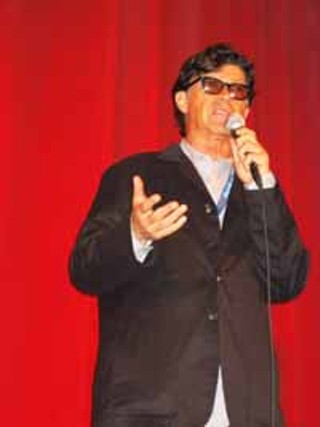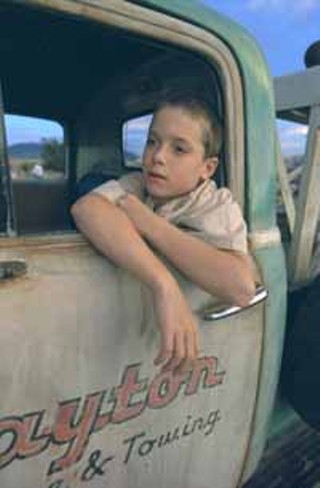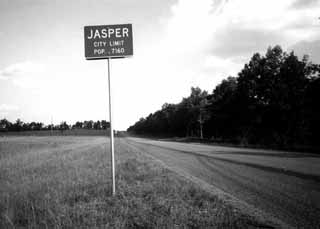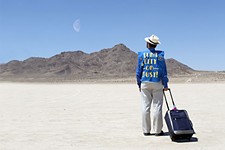Curtain Call
SXSW 2002 Film Reviews
Fri., March 22, 2002

Rock of Ages: 'The Last Waltz'
There are some who might take issue with a refurbished, remastered The Last Waltz, some who believe that such touches are akin to tampering with a graveyard landmark, a tombstone whose aging and oxidation only add a rustic dignity, a dignity that should be left alone. In this case, that tombstone would be the Band's, and to those mourners I'd say it's high time to take another visit. Everything is still in place: The coke is still stippling Neil Young's nostrils, Eric Clapton's guitar strap still comes loose during his duel with Robbie Robertson, and you still can't tell if Levon Helm is pissed or confused or just used to it (or all three) when Bob Dylan switches midsong from "Forever Young" to Gary Davis' "Baby Let Me Follow You Down." Martin Scorsese's lighting and composition are still just far enough from perfect to make it all so raggedly gorgeous, and that wraparound shot of the Staples Singers during "The Weight" still provides a stunning contrast to the brokedown palace known as the Winterland Ballroom. Otherwise, everything looks and sounds better. Colors, images, and interviews are crisper. Joni Mitchell's "Coyote" is making noises it never made on the original cut, noises that were there on Thanksgiving night, 1976, and are rightly there now for people who weren't. The garage rock reverb during Rick Danko's "Stage Fright" now shakes the skull as forcefully as the tubas and trombones of Helm's "Ophelia." Garth Hudson's silhouette looks even more like the ghost of electricity during his organ fills, and Richard Manuel's death-row warble is a sound for sore ears.
I think the crowd assembled for Friday night's premiere at the Paramount understood all of that. The demographic probably wasn't much different from the crowd who gathered for the farewell concert that The Last Waltz immortalizes: There were young and old, scenesters and regular old fans, musicians, artists, filmmakers, journalists. And Robertson was there. While he's not quite the hot-headed, cool-handed cock of the walk he once was, and while he was nowhere near as talkative before the film as he is during the film, it was still rather cool to have him around. "This will be the first time I've gotten a chance to judge the sound and see the print," he said. "I'm excited about it." Man, so was the crowd. At times it was hard to tell where the cheers were coming from -- the onscreen or in-house audience. Whether it was like being there 25 years ago isn't really my call to make, considering I had yet to be conceived; whether it's the best rockumentary ever made isn't mine, either. But on Friday, there was no question. -- Shawn Badgley
The Last Waltz's newly remastered 4-CD soundtrack will be released in April. Its DVD will be released in May.
By Hook or by Crook
D: Harry Dodge, Silas Howard; with Howard, Dodge, Stanya Kahn, Carina Gia.
Narrative Feature, Competition
The opening scenes of By Hook or by Crook take place in rural Kansas, and although Shy (Howard), the gender-bending butch lesbian who lives there, skedaddles to the city, the hard-bitten, gritty feel of the plains suffuses this meandering but restlessly inventive first feature. Embarking on a life of petty crime, Shy, who's never really recovered from her father's death, meets up with Valentine (Dodge), a fellow grifter who is searching for her birth mother. Frenetic, kooky, and all nervous, jangly hands, Valentine, who senses she is composed of "all the wrong kind of chemicals," is an utterly unique and fascinating creation, with a demon child's energy but the hard-won experience of someone much older. Plot isn't the name of the game in this slightly inchoate creation, which won the Audience Award among narrative feature films screening at SXSW. The filmmakers are more invested in marking out a space where androgynous love is an everyday occurrence, but with characters as engaging as these, getting to the last reel is far from a chore.
-- Clay Smith
Garmento
D: Michele Maher; with David Thornton, Katie MacNichol, Jerry Grayson, Saundra Santiago.
Narrative Feature, Special Screenings
Poncho Ramirez's padded jock strap flopped. His name -- which once graced the back pocket of every woman's too-tight jeans -- has become a punchline. That's when Grindy Malone, small-town, starry-eyed ingénue, lands a job with Poncho Ramirez and turns that sucker around. Sure, it takes a little fraud and deception, but this is fashion, after all -- fraud and deception are their bread and butter. Writer/director Michele Maher, who gathered her ammunition working in the New York fashion houses, has made a broad but fairly pedestrian satire of America's real Evil Empire. Garmento's gags are amusing but dated (Poncho Ramirez reminded me most of Calvin Klein, with comic bits about over-the-top controversial ad campaigns and marketing Poncho's name as his initials, PR), and the story itself -- good girl seduced by bad people -- isn't much. Still, the fashion world could use a few solid punches, and every once in a while, Garmento lands a good one. -- Sarah Hepola
1 Giant Leap
D: Jaime Catto & Duncan Bridgeman; with Brian Eno, Mahotella Queens, Linton Kwezi Johnson, Kurt Vonnegut, Michael Stipe, Speech, Dennis Hopper, Neneh Cherry, Tom Robbins.
Documentary Feature, Special Screenings
Don't mistake this musical trek across the globe for one of those feel-good United Airlines or AT&T or Nike commercials. Sure, the montages of faces old and young honoring a painter's palette of skin tones smacks of one of those multinat ad campaigns, but 1 Giant Leap's directors traveled far and wide to reveal profundities a bit more serene and sincere. After all, human existence is, as repeatedly stated in the film by Dennis Hopper, the real miracle of this world. And looking into the sweet, smiling grandmotherly faces of the Mahotella Queens as they address the camera directly while chiming away in glorious harmony makes the case better than any sneaker ad ever could. Nods to Eighties scratch-editing groundbreakers Koyaanisqatsi and the David Byrne & Brian Eno LP from the same era, My Life in the Bush of Ghosts, are abundant, as the film presents a number of themed vignettes, covering topics like "Inspiration," "Spirituality," "Sex," etc., each featuring a different group of musical artists, recorded in their own respective countries and assembled together later on film in gorgeous layers. -- Kate X Messer

Just a Dream
D: Danny Glover; with Jeremy Sumpter, Carl Lumbley.
Narrative Feature, Special Screenings.
The magic of the movies and the waning of childhood optimism come together in this warm-hearted period piece set in the early 1960s that marks veteran actor Danny Glover's directorial debut. When 12-year-old Henry Sturbuck (the marvelous Jeremy Sumpter) takes a summer job in a small-town tavern, he finds himself surrounded by adults whose dreams have been stuffed into quiet sorrow or masked with bravado and lies. Chief among them is a stoic mechanic (Alias' Carl Lumbley), who introduces Henry to the movies and the magic of his favorite movie star, Marilyn Monroe. When the production of The Misfits comes to town, Henry excitedly discovers the allure of dreams. But his real discovery comes when his childhood reaches the crest of adulthood, and he sees how painful, precious, and bitter dreams can be. -- Belinda Acosta
Six in Austin
D: Various.
Narrative Feature, Special Screenings
Brothers Wyatt and Zack Phillips half-cursed their compilation of the work of eight Austin DV filmmakers by modeling it on 1965's Six in Paris. Living up to the legacy of a film that united 16mm shorts by such heroes of the New Wave as Jean-Luc Godard, Claude Chabrol, and Eric Rohmer is a difficult task (and one that's been assayed before by at least two higher-profile compilations), and so watching the Austin update of Paris Vu Par consistently reminds one of two sad facts: Austin circa 2002 is no Paris circa 1965, and digital video -- no matter how much you mess with the white balance -- is no 16mm. Still, Six in Austin has enough great moments (the lovely photography of Kat Candler's otherwise heavy-handed "The Absence of Wings," the quiet simplicity of the Phillips brothers' "Carlos," and the whole of David and Nathan Zellner's hilariously pitiful "Rummy") to make up for its more awkward ones (Gonzalo Gonzalez's leaden and improbable "Beset"), and enough glimmers of magic to make a case for the sound health of a truly independent film scene in Austin. -- Will Robinson Sheff
The Smith Family: For Better or Worse
D: Tasha Oldham.
Documentary Feature, First Films
It certainly sounds like the stuff of fiction: A loving Mormon husband confesses to his devout and devoted wife that he's been cheating on her with men, one of whom has infected him with HIV, which the husband has since passed on to his wife. The Smith Family is the documentary-telling of that Mormon family and the pain, betrayal, heartbreak they must endure as the father slowly succumbs to AIDS. The couple and their two teenage sons are open with the camera, willing to voice their anger and their love. But while their story is moving -- how could it not be? -- and even uplifting, director Oldham's work is like a constant pinprick, deflating our investment in the story with her poor camerawork, jarring transitions, and what seems to be a blithe ignorance of questions that beg to be answered (i.e., the family's evolving relationship with the church, with homosexuality, with each other). One gets the sense Oldham has allowed the Smith family to shape the documentary, and not the other way around. The family reveals as much as they choose to, and while the heart is stirred by what they have to say, the head keeps buzzing, frustrated at how much is left unsaid. -- Kimberley Jones

Texas
D: Circumstance; with Russell Crowe.
Documentary Feature, Special Screenings
Oscar-totin', antipodean hunkster Russell Crowe came to town to introduce the premiere of Texas, the documentary about his side-project band 30 Odd Foot of Grunts' trip to Austin. "As one guy put it," began the scruffy, self-effacing movie star, "'music is its own reward.'" Were this true, were music truly the message, this 567,000 odd feet of groan-inducing footage would've been comfortable premiering at, say, the 59-seat theatre at the Hideout. The only reason Texas showed in such a prestigious slot was Russell Crowe. Is that such a bad thing? Well, if you aren't a Russ devotee, it is. Fortunately, fans of the beefy Aussie were in attendance in legion at the Paramount Theatre, and if the laughter in all the intended spots is any indicator, they "get" the band and loved this peek behind the scenes. But for the rest of us, it was two hours of mildly annoying torture, like a VH1 Behind the Music marathon gone terribly wrong: See TOFOG as they really are -- a marginally decent pub-rock band with a famous lead singer! See TOFOG having their 15 minutes! See TOFOG mug insipidly! See TOFOG desperately try to communicate to anyone who'll listen, "We're just regular blokes ... no, really!" Bright spots? Sure. As a straightforward love letter to fans, it's sweet. The filmmakers avoid exploiting the mostly forty/fiftysomething group of devoted bra-flinging female fanatics for yuks, and in these days of T&As and Girls Gone Wild, that is somehow noble. As a love letter to Austin, it's also sweet; these guys clearly loved being here. And as an odd exploration of the truism that states that musicians really want to be movie stars and vice versa, it unwittingly succeeds (albeit, sans psychoanalysis). Unfortunately, despite the "Live Music Capital of the World" setting, what Texas can't address is this: What is the difference between playing a rock star and being one? -- Kate X Messer

Two Towns of Jasper
D: Whitney Dow, Marco Williams.
Documentary Feature, Special Screenings
Without a gimmick, the subject is devastating enough: the brutal, unconscionable murder of James Early Byrd Jr. and its aftershocks on the East Texas town of Jasper. Make that two towns: The documentary presents the tragedy not as an isolated hate crime, but rather as the product of a dyed-in-the-wool racial divisiveness, both in Jasper and America as a whole. They say the camera doesn't lie, and this camera certainly adds fuel to the fire: With fly-on-the-wall surreptitiousness, documentarians Dow and Williams lens Jasper residents in the places they feel most at home -- the beauty parlor, the golf course, the projects, the church pews, the Main Street coffee shop. The camera has startling access to the innermost, ugliest thoughts of these residents, something that has a lot to do with that gimmick: Dow and Williams took two separate crews to Jasper -- one white, one black -- and each crew interviewed people of their own race. We never see the crews, but it's clear they got what they were looking for: unflinching candor. One white Jasper man lifts his shirt for the camera -- a white camera -- to expose a torso stenciled with Aryan Power tattoos. It's a powerful statement about the presumed unifying force of skin color. The film speaks a lot about the nature of race in America today ... but does it speak enough? The white/black gimmick affords the filmmakers immeasurable access, but they never offer their own commentary, nor to do they allow us to see just how they convinced interviewees to take them into their confidence. The argument could be made that objectivity is the goal of a good documentary, but from the opening text explaining the situation, the documentarians have inserted themselves into this wrecking human drama; they're there in every frame of the film, just unseen. The filmmakers could have challenged assumptions, but instead chose to reinforce them from day one by dint of their self-imposed segregation. That fact doesn't diminish from the significance of Two Towns of Jasper -- in fact, it adds another layer of complexity and consternation -- but the filmmakers simply stopped too short. Here, the camera doesn't lie, it just doesn't tell the whole truth. -- Kimberley Jones










